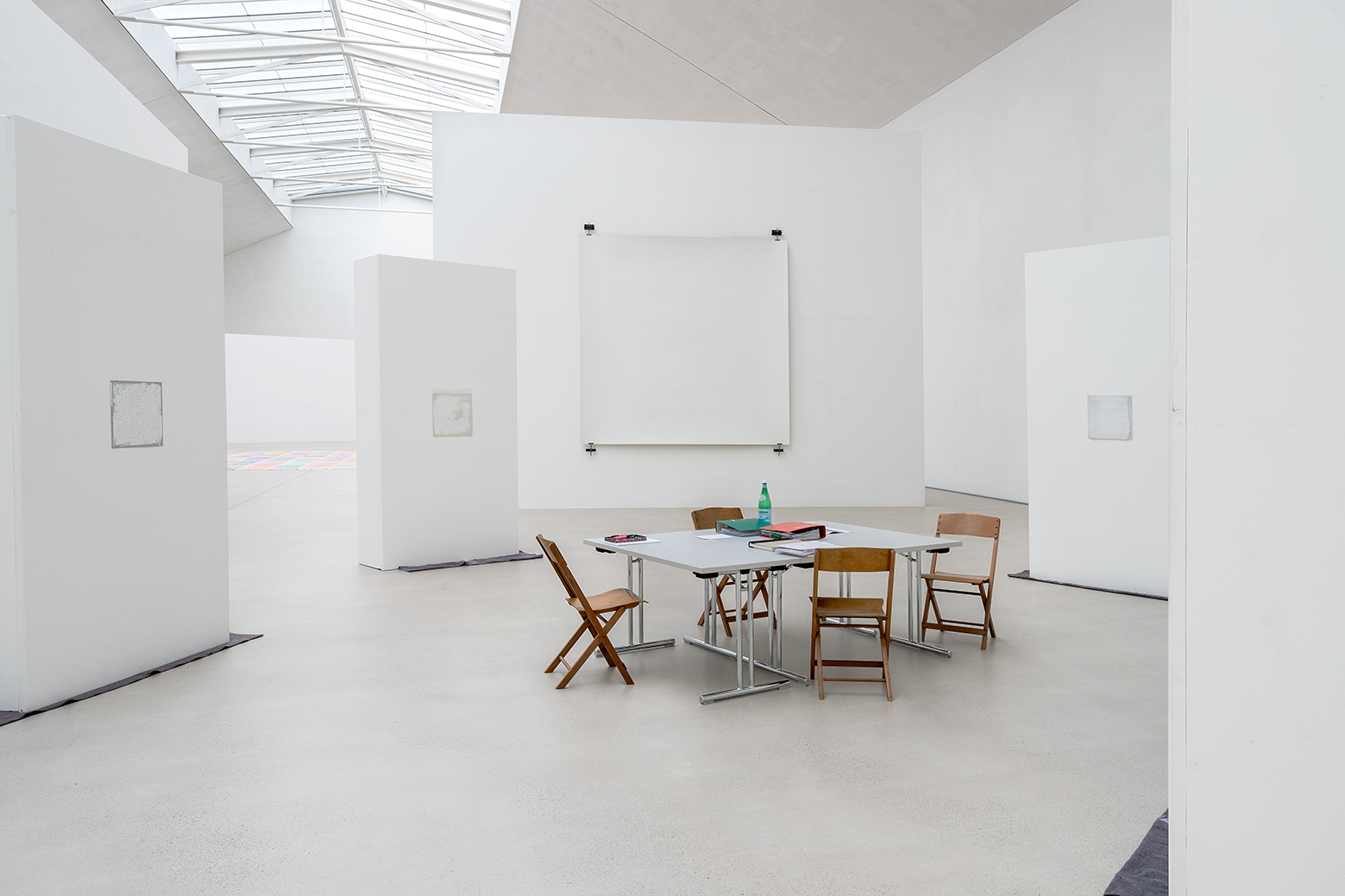A creative process: Robert Ryman’s Versions
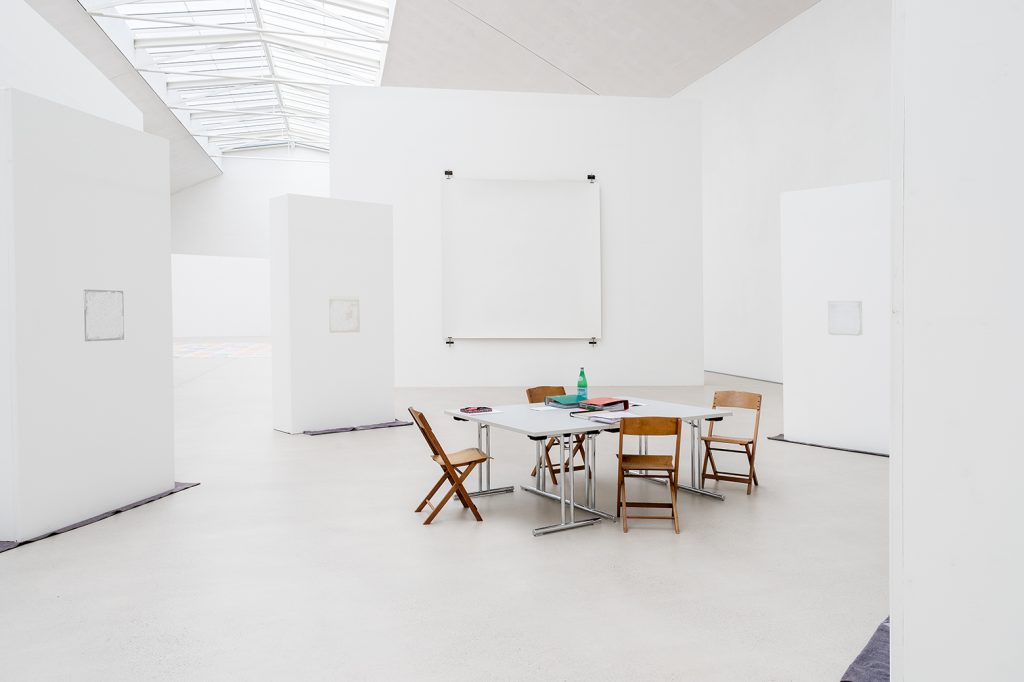
The motivation
Between 1977 and 2010 Urs Raussmüller, himself an artist, regularly spent intensive weeks with Robert Ryman in the latter’s studio on Greenwich Street, New York. He took a great interest in the creation of Ryman’s paintings, talked at length with his friend about the interaction between the artwork and its surroundings, and unearthed works that had been stored away (and forgotten) in the warehouse and garage. Together they mounted fifteen international exhibitions during these years, in each case devoting the greatest attention to how the paintings worked together with the light and space.1 Their final, unparalleled installation at the Hallen für Neue Kunst, Schaffhausen, was titled Advancing the Experience – which perfectly describes the process of their approach and the insights thereby gained.2 Ryman great valued Raussmüller’s advice and opinion, and would ask him to come to New York each time he embarked on a new work series.3 As part of his practice, Ryman often executed his idea for a painting in several variants, until he felt finished with the subject. The prompt for a pictorial concept was frequently provided by new materials that Ryman was eager to try out, but it could also come from an inspiring proposal – as in spring 1991.
Urs Raussmüller was at that time preparing a Ryman exhibition at Renn Espace d’art contemporain in Paris, the new art space he had created for the film producer and art lover Claude Berri. Raussmüller had constructed light-filled rooms beneath a large glazed roof, and promised Robert Ryman that he would bring out the effect of his paintings to the full under the special Paris light.4 During the preparations for the installation, Ryman confessed that he was uncertain how his painting should develop after this manifestation. Raussmüller invited Ryman to draw a line under his oeuvre up to that point and take a fresh approach. He offered him an exhibition at the Hallen für Neue Kunst in Schaffhausen the following year, at which Ryman could show the new works he was producing, and at the same time measure what he was now doing against the installation of his paintings on the Hallen’s skylight floor. In place since 1983 and comprising some fifty paintings, this Ryman retrospective demonstrated an impressive wealth of convincing pictorial effects – making Raussmüller’s proposal a genuine challenge. His ambition aroused, Ryman was motivated and embraced Raussmüller’s suggestion.
On 10 May 1992, in the presence of the artist, Urs Raussmüller opened the exhibition Robert Ryman: Versions.5 It was a surprise. The sixteen paintings that Ryman had executed between summer 1991 and spring 1992 were unlike any he had made before. On slender fibreglass panels ranging in size from 13 x 13 inches to 84 x 84 inches,6 he had applied white oil paint in such a way that it formed flat, open zones in some cases, and stood out in relief in others. Along the upper edge of each panel, he had attached a strip of wax paper, which acted as an additional reflective surface for the light and at the same time subtly extended the painting onto the wall. The painted panels were held in place by thin, slightly protruding nails, often painted white – something quite new in Ryman’s work. They emphasized the Versions’ weightlessness and corresponded, with the shadows they cast, to the three-dimensional effect in the impasto parts of the paintings.
No other series in Ryman’s oeuvre shows a comparable openness in its painting, such an obvious relinquishing of the notion of how ground and paint application traditionally relate to each other, or more specifically, of how a painting should be constructed and exert its effect. As a rule, Ryman’s work series are variants of a basic form – we might think here of the Standards of 1967, the Classico group of 1968/69 and the Generals of 1970. The Versions, on the other hand, display no uniform pattern. In the diversity of their appearances, they are instead the expression of a process of development, an intuitive creative method whereby the artist lets the works take shape with an increasingly open mind. “Painting happens in the act of doing it, and that is when discovery is made. When I first began these recent paintings, the Versions, I had no idea that they would come out the way they did. I did not know how they would come out and I had to let them develop. I had to let the paintings tell me how they were going to be. […] I am talking about the surprise that comes about through the act of painting.”7
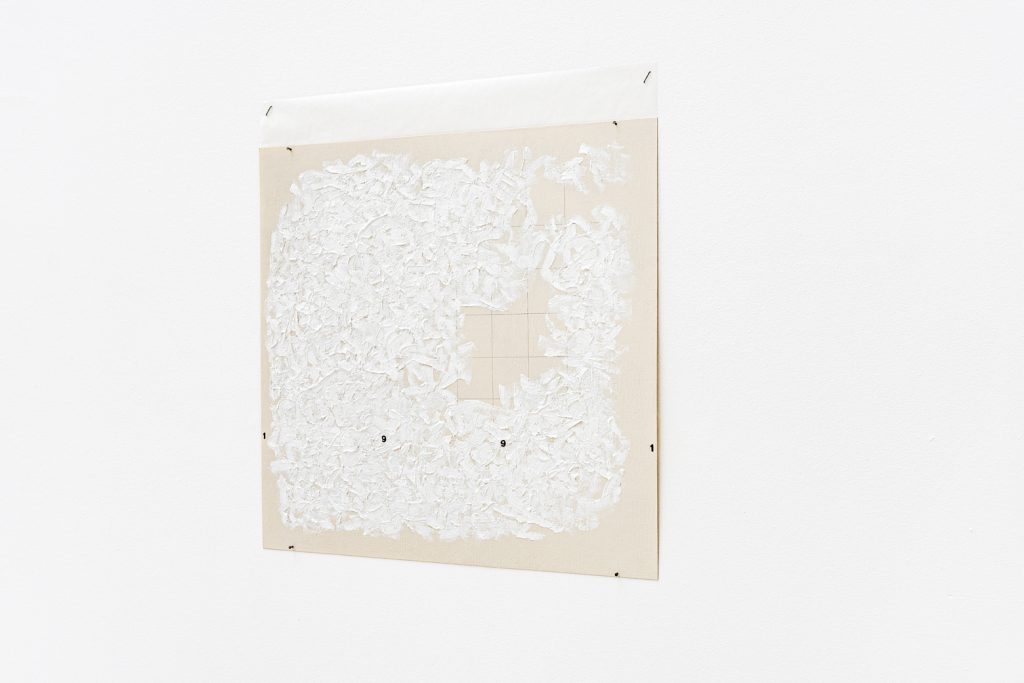
The creative process
Produced between summer 1991 and spring 1992, the Versions epitomize the principle of a creative process. At the start of the new work series, the artist still links back to the familiar. Then he becomes increasingly bold: the pictorial concept gains in clarity and the artist in confidence in his approach. At some point he reaches a high point, at which he leaves behind everything that determined his original idea. He now commands a freedom that allows him to grow beyond what has gone before. After that, no further escalation is possible; what he has created no longer surprises him, and he returns to the familiar. He executes the final Versions and the process is completed. For his work to develop further, the artist needs a new approach.
What in this case applies to Robert Ryman, is true for every form of creative activity. A creative process is not a fast, and above all not a planned procedure. The result is not foreseeable, because it only develops as work progresses. In the Versions, it becomes clear how this process unfolds over time, with recourse to what has gone before and varying ideas. Each result also yields fresh insights, which flow into the following works and occasionally lead to alterations to earlier ones. What gradually revealed itself to the artist in this case was the way in which paint and ground interact with the wall surface, and how they coalesce or project forwards into space: “the surface is built up slowly and can expand through the space of the structure. On certain areas it can become more opaque through the addition of more paint. It is hard to say exactly how I do that, because it develops on its own.”8
The Versions are a work series, but each painting has a status of its own. Ryman has titled all the works Versions – in the plural – and thereby emphasized their commonalities. How great the differences in their design and execution are, i.e. to what a variety of results the process of their creation has led, only becomes apparent when they are seen side by side. The fact that the artist has labelled each of the Versions with a Roman numeral does not reflect the chronological order in which they were painted. Versions I, II, III and IV, for example, were only produced in 1992. In several Versions Ryman has made the year number a compositional element, but the dating is only a minor clue to the painting’s position within the genesis of the whole group. If we wish to re-trace the process of their creation, we must follow the steps by which the artist proceeded – as we shall see, these are largely visible in the works.
As a start to the exhibition in the Hallen für Neue Kunst hung the painting Permit of 1991.9 Ryman did not incorporate this work into the Versions group, but regarded it as a preparation for his series. He did not show Versions XVI, the last of the series, as he was not satisfied with the result and wished to rework it. Permit, on the other hand, clearly shows the starting point from which the Versions took shape. The support and technique are already those that Ryman would use in the following paintings. Permit also already features a strip of wax paper along its top edge, is fixed to the wall with slender nails and, like Versions VIII, X, XI and XIII, contains the date 1991, divided into 19 and 91. The surface, however, is still painted in a closed, all-over manner, as in earlier Ryman paintings, i.e. without the openings characteristic of the Versions.
Versions VI from the same year, whose dimensions and materials are identical to Permit, appears by comparison like a major step forward towards a painting that, in unpainted, open areas, incorporates the ground as a striking part into the pictorial effect. With these irregular openings of the paint surface, Ryman creates for himself the possibility of applying his white paint in some places in an impasto and opaque manner, in others thinly and in transitions of great delicacy into the zones left free, and – by building up his paint material – of lending the work, in itself extremely flat, a sophisticated three-dimensionality and expansion forwards into the room.
Closely related to these two paintings are Versions V and VII. As versions, they seem to fall between the closed surface of Permit and the interrupted paint surface of Versions VI. The paint application in both works is relatively dense and yet produces two very different effects. Their comparison is like an answer to the question of where, in which area, the painting should be opened up: more in the centre of the painting, as in Versions VII, or more towards the edge, as in Versions V? Ryman has pursued both possibilities and thereby in each case produced new effects. In the case of Versions VI, we find an additional element that Ryman also employs in Versions VIII, XI and XIII from 1991, as well as in I, III and IV from 1992: a grid of graphite lines lying beneath as well as on top of the white oil paint. The artist has thereby added a further layer to the painting mounted flat against the wall, one that accentuates its subtle spatial composition. The lowest level is the wall, followed by the wax paper fastened in place with staples. On top of the paper is the thin fibreglass panel with its primer, grid drawing and paint applied in relief. Projecting furthest into the room are the protruding nails. Together these add up to the remarkable layering of what is at the same time a very flat work.
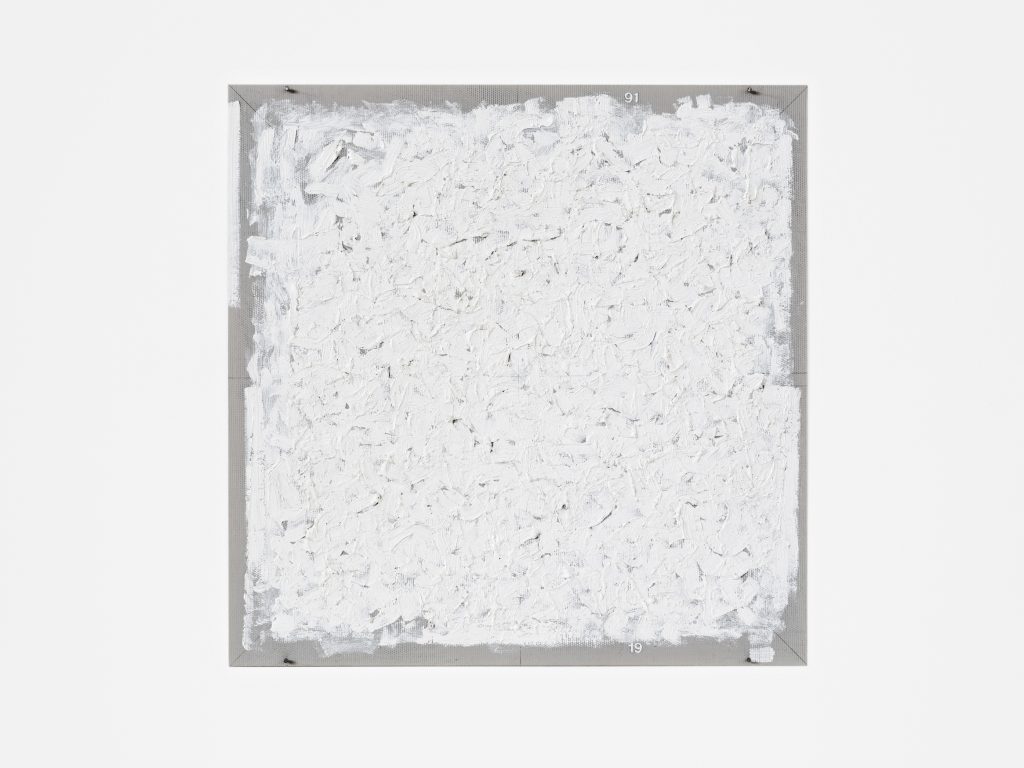
With its entire surface painted apart from the zones left free around the periphery, the significantly smaller Versions VIII (15 x 15 in.) of 1991 has all the appearance of a classic Ryman work. The manner of painting is more vigorous and animated than in earlier works, however. The smaller format has heightened the expressiveness of this paint application and emphasized the structure of the surface. It shows a paint surface built up in relief, which gives way in subtle transitions to the clearly demarcated, unpainted border area. Here, too, Ryman has integrated the year number, divided into 19 and 91. Unlike in the other Versions, however, he has dispensed with the wax paper strip along the top of the picture. In this case, he has indicated the transition to the wall by means of a vertical strip of white on the left-hand edge, and underscored the expansion of the painted plane by means of pencil lines, laid down prior to painting and leading diagonally into the corners of the picture.
Ryman’s Versions show, with a large range of variation, the process of development in the pursuit of an initially still vague idea. In this case, the project to lend shape to the spatial dimension of a painting – both in its interaction with the surrounding room and in the composition of the painting itself – inspires a procedure whereby the artist continuously draws conclusions for new solutions from the results he has achieved. This is more than just trying out an idea in multiple variants. It is the endeavour to arrive, through this process, at a result unsurpassable in its cogency. Whether and how this is achieved, cannot be planned. “It develops on its own”, as Ryman says. What he set out to do was simply to use paint in a different way: “I wanted to work more directly with paint than I had before. […] in the Versions I wanted to let the paint itself have more importance in terms of how it functioned as opposed to ways I had used paint in the past.”10 What emerged was a new pictorial effect, produced by a previously unknown opening of the painted surface.
In the Versions it becomes apparent how, by applying his paint more or less opaquely on panels of different sizes and in association with other elements such as the year numbers, the graphite grid and the colour of the primer, Ryman translated the effects of the broken-open surface into experiences. His switch to smaller formats was thereby a way of moving towards bolder solutions. In Versions X and XI, for example, Ryman used black paint in order to place the date 1991 as a striking pictorial element next to and on top of the white paint surface, and in so doing to create yet another layer. The painting as a whole becomes freer and more open in this process; the painted areas seem to detach themselves from the ground and flourish independently of the square plane. The paint fields are more rounded and the spaces in between more irregular. In Versions XII, 1991, and the later Versions XIV, 1992, Ryman also introduced a new material: a primer in an interference colour that assumes a neutral or blue hue depending on the fall of the light, and which lends the paintings an iridescent radiance.
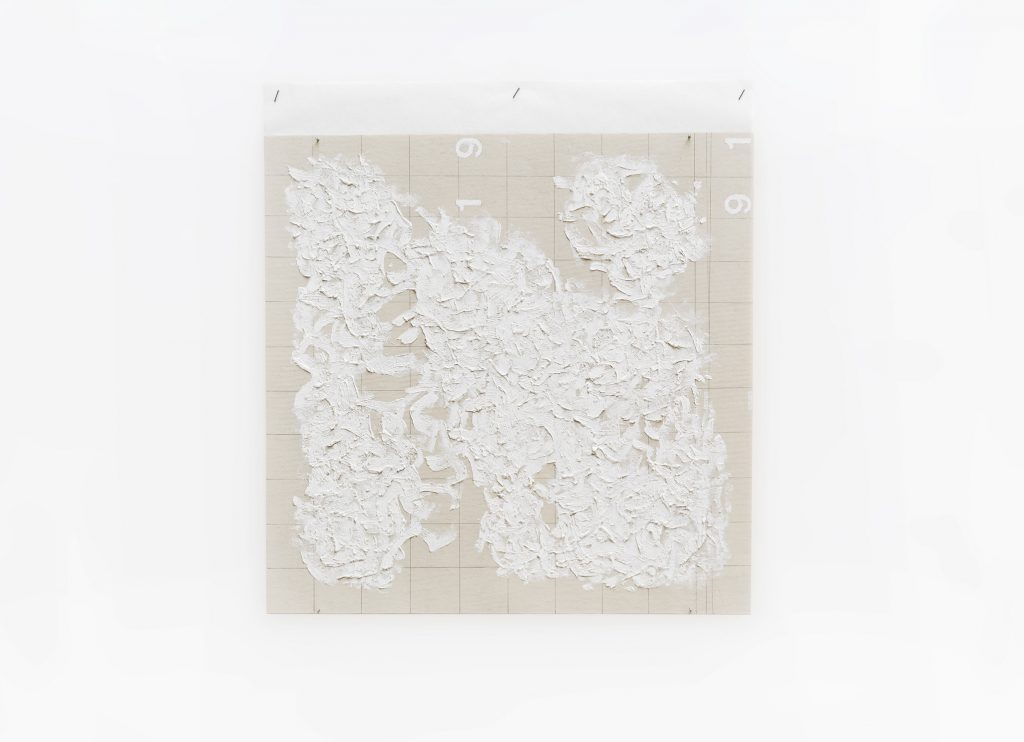
Versions XIII of 1991 (21 x 19 in.) is already an expression of great freedom. It combines the elements of the pencil drawing and the date with a partly opaque, partly permeable painting, whose areas of paint intertwine with a certain dynamism. In its structure, as in its forms, this painting steps forward as pure paint, literally leaving the gridded ground behind. The brushwork in the smaller Versions of this phase is loose and animated, and the paint is applied in short, directionless strokes. Next to the ground, which is left unpainted, the build-up of the paint material becomes particularly evident. As the density of the paint increases, so does the radiance of its shade of white, leading in the Versions to a wealth of nuances. Over the course of the day, the changing angle of the light produces surprising changes in their pictorial effect. The painted surfaces absorb the light and radiate it out again in subtle gradations. Complemented by the mother-of-pearl sheen of the wax paper, they offer the fascinating spectacle of the interaction of painting and light.
The relief-like structure of the paint application, which lends so much character to the effect of the smaller Versions, becomes secondary in the large panels to the overall effect of the variously interrupted areas of paint. In 1992 Ryman completed four paintings whose dimensions – excluding the strip of wax paper along the top edge – range from 63 to 84 inches (160 and 213 cm) square: Versions I, II, III and IV. These works, too, are executed in animated fashion with a narrow brush, whereby the eye is drawn first and foremost to the variously shaped areas that have been left blank. The value of the thin fibreglass material becomes particularly apparent in these works: despite their size, the flat panels hang weightlessly on the wall. Among these paintings, Versions IV embodies the most radical version: here the pictorial surface is divided into two parts, which are separated by an open vertical centre line as in a Rorschach test. The smaller Versions XV, likewise executed in 1992, shows two similarly separated paint fields on a 15 x 15 inch panel.
In this phase of the comprehensive working process, all aspects of building up the picture in layers, and of what Ryman described as “[working] more directly with paint”, seem to have taken on form. In the richness of their effect, the results manifest an artistic process pursued to the point at which no further escalation is possible. The “surprise that comes about through the act of painting” (Ryman) is greatest when this act is least directed. In the process of development of the Versions, this surprise reached its apex in the startling radiance of the small Versions XIV. Four white, cloud-like fields float in front of the iridescent ground, as lightly and freely as if they were completely detached from it. Evident in this work is a degree of artistic freedom that can only be achieved by allowing intuition to lead the way: “I had to let the paintings tell me how they were going to be.” In this case, the result was achieved so naturally and self-evidently that the artist could carry the process no further forward. In the final Versions XVI, Ryman reverted to a tried and tested way of painting and ended the work series.
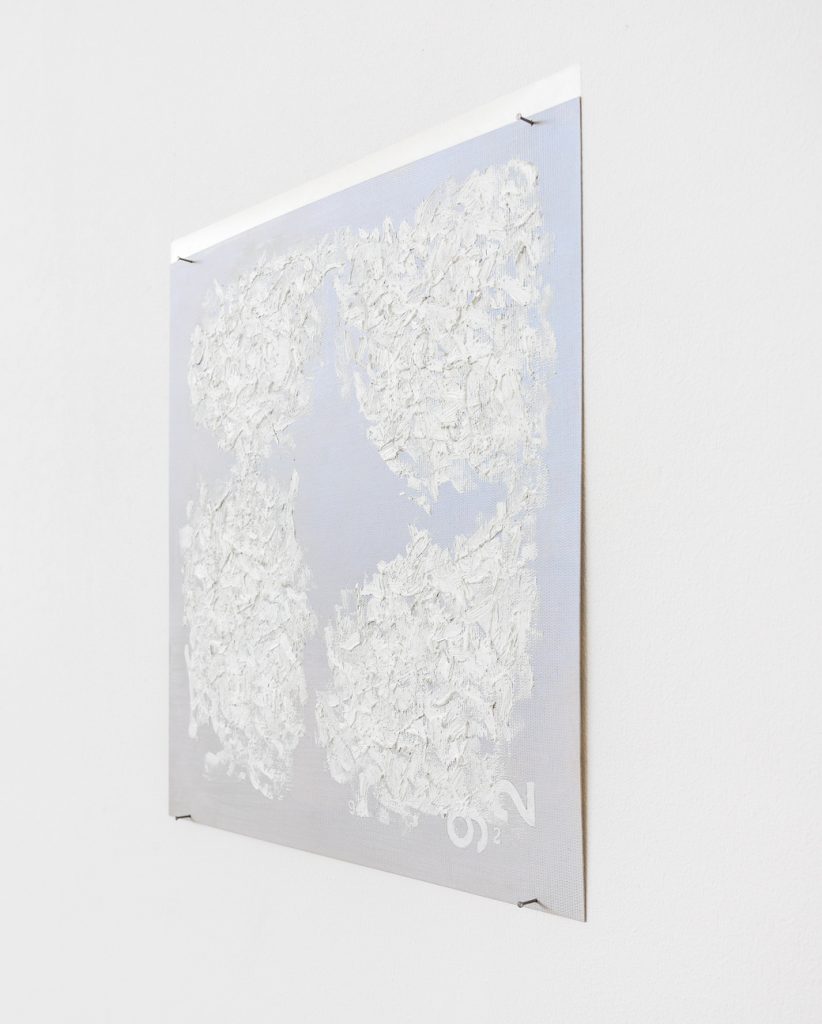
The text was written following statements made by Urs Raussmüller on 14 July 2022 about the artistic process, and more specifically about the creative process as a fundamental principle of innovative behaviour.1 A list of Raussmüller’s Ryman exhibitions and installations can be found in: Sauer, Christel/Urs Raussmüller (eds.), Urs Raussmüller: Ryman Paintings and Ryman Exhibitions, Frauenfeld/Basel 2006, pp. 60–62.
2 See Sauer, Christel/Urs Raussmüller, Robert Ryman and Urs Raussmüller: Advancing the Experience, catalogue of the exhibition at the Hallen für Neue Kunst, Schaffhausen, Basel 2010.
3 “Urs is probably the only person who has a full understanding of how the paintings act and how they can be put together.” Robert Ryman in: “Robert Ryman und Urs Raussmüller: Das Werk. Ein Gespräch in den Hallen für Neue Kunst, Schaffhausen, am 24. Mai 2008”, in: Sauer 2010, p. 87.
4 Installation views in: Sauer, Christel/Urs Raussmüller, Robert Ryman, Schaffhausen 1991 (book accompanying the exhibitions at the Hallen für Neue Kunst, Schaffhausen, and Renn Espace d’art contemporain, Paris).
5 Hallen für Neue Kunst, Schaffhausen, 10.5.1992 – 31.10.1992 / The Pace Gallery, New York, 4.12.1992 – 2.1.1993. See the exhibition catalogue Sauer, Christel/Urs Raussmüller (eds.), Robert Ryman: Versions, Schaffhausen 1992.
6 For the dimensions of the individual Versions, see Appendix.
7 Sauer 1992, p. 30.
8 Ibid., p. 36.
9 Permit, 1991, oil on fibreglass with wax paper, 45 ¾ x 41 in. / 116.2 x 104.2 cm.
10 Sauer 1992, p. 34.
Appendix
Versions I, 1992, oil and graphite on fibreglass with wax paper, 91 x 84 in. / 231.3 x 213.1 cm
Versions II, 1992, oil on fibreglass with wax paper, 79 x 72 in. / 200.7 x 182.8 cm
Versions III, 1992, oil and graphite on fibreglass with wax paper, 71 x 63 in. / 180.4 x 160.1 cm
Versions IV, 1992, oil and graphite on fibreglass with wax paper, 78 x 72 in. / 198.1 x 182.8 cm
Versions V, 1991, oil and graphite on fibreglass with wax paper, 45 x 41 in. / 114.4 x 104.2 cm
Versions VI, 1991, oil on fibreglass with wax paper, 45 ¾ x 41 in. / 116.2 x 104.2 cm
Versions VII, 1991, oil on fibreglass with wax paper, 44 ¼ x 41 in. / 112.4 x 104.2 cm
Versions VIII, 1991, oil and graphite on fibreglass with wax paper, 15 x 15 in. / 38.1 x 38.1 cm
Versions IX, 1991, oil on fibreglass with wax paper, 14 x 13 in. / 35.6 x 33 cm
Versions X, 1991, oil on fibreglass with wax paper, 16 ½ x 15 in. / 41.9 x 38.1 cm
Versions XI, 1991, oil, graphite and ink on fibreglass with wax paper, 19 x 17 in. / 48.3 x 43.2 cm
Versions XII, 1991, oil and interference primer on fibreglass with wax paper, 18 ¾ x 17 in. / 47.6 x 43.2 cm
Versions XIII, 1991, oil and graphite on fibreglass with wax paper, 20 x 18 in. / 53.4 x 48.3 cm
Versions XIV, 1992, oil, interference primer and graphite on fibreglass with wax paper, 13 ½ x 13 in. / 34.4 X 33.1 cm
Versions XV, 1992, oil and graphite on fibreglass with wax paper, 15 5/8 x 15 in. / 39.7 x 38.2 cm
Versions XVI, 1992, oil and graphite on fibreglass with wax paper, 14 ¼ x 13 in. / 36.2 x 33 cm
© Christel Sauer, August 2022
Photo credit: © Raussmüller
Translated from German: Karen Williams
